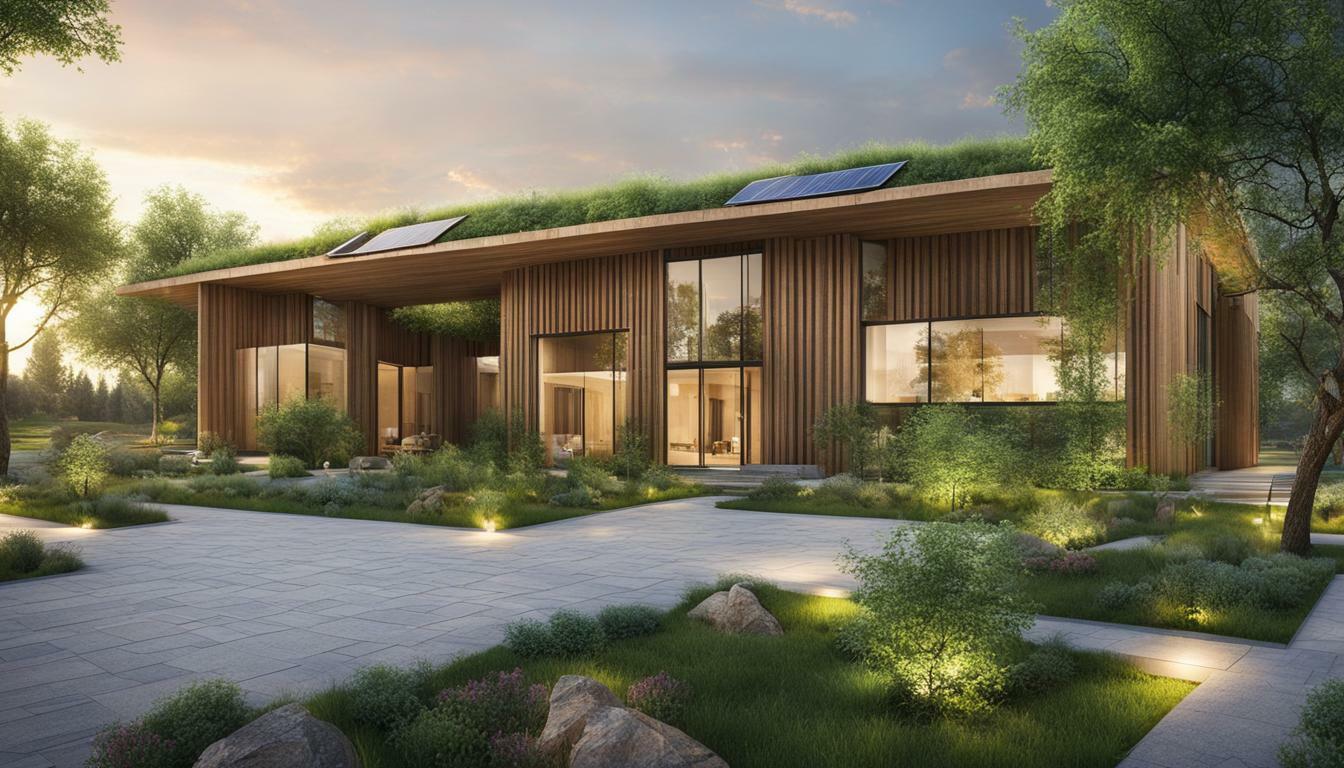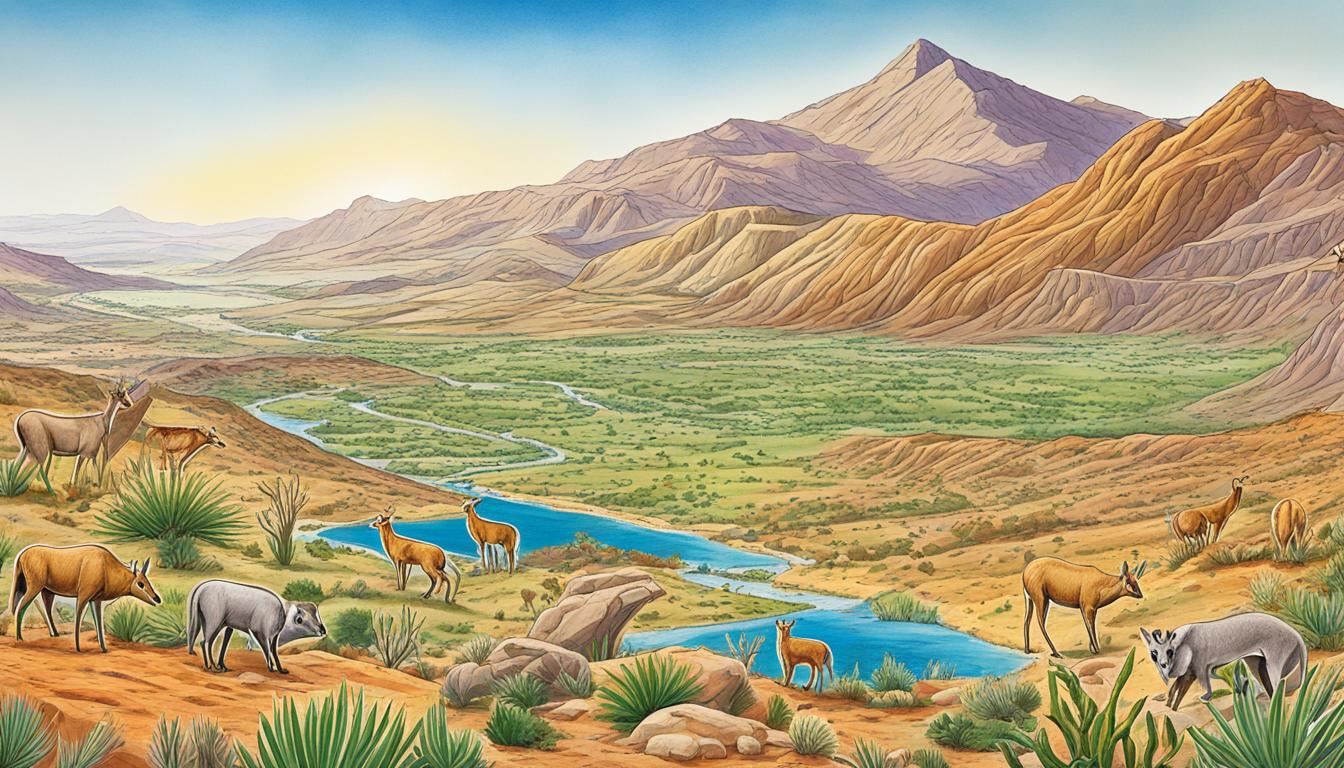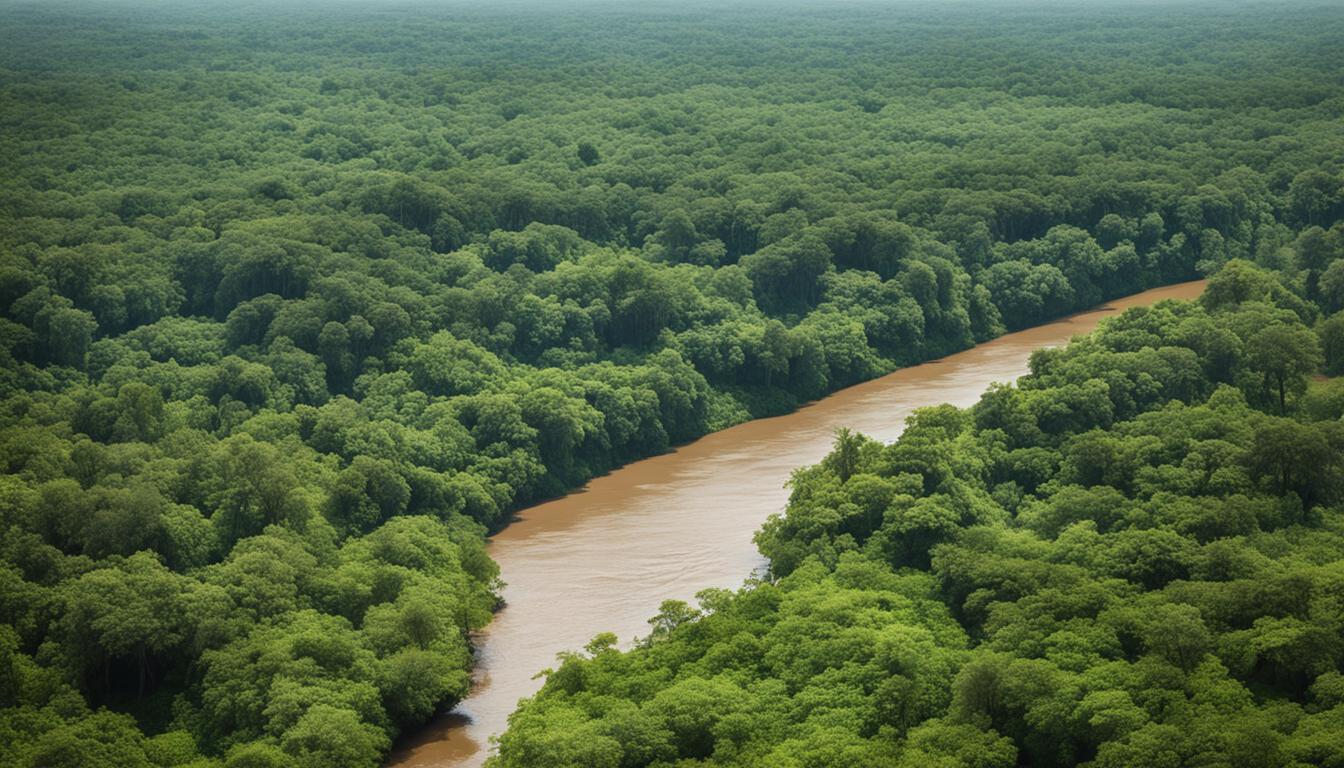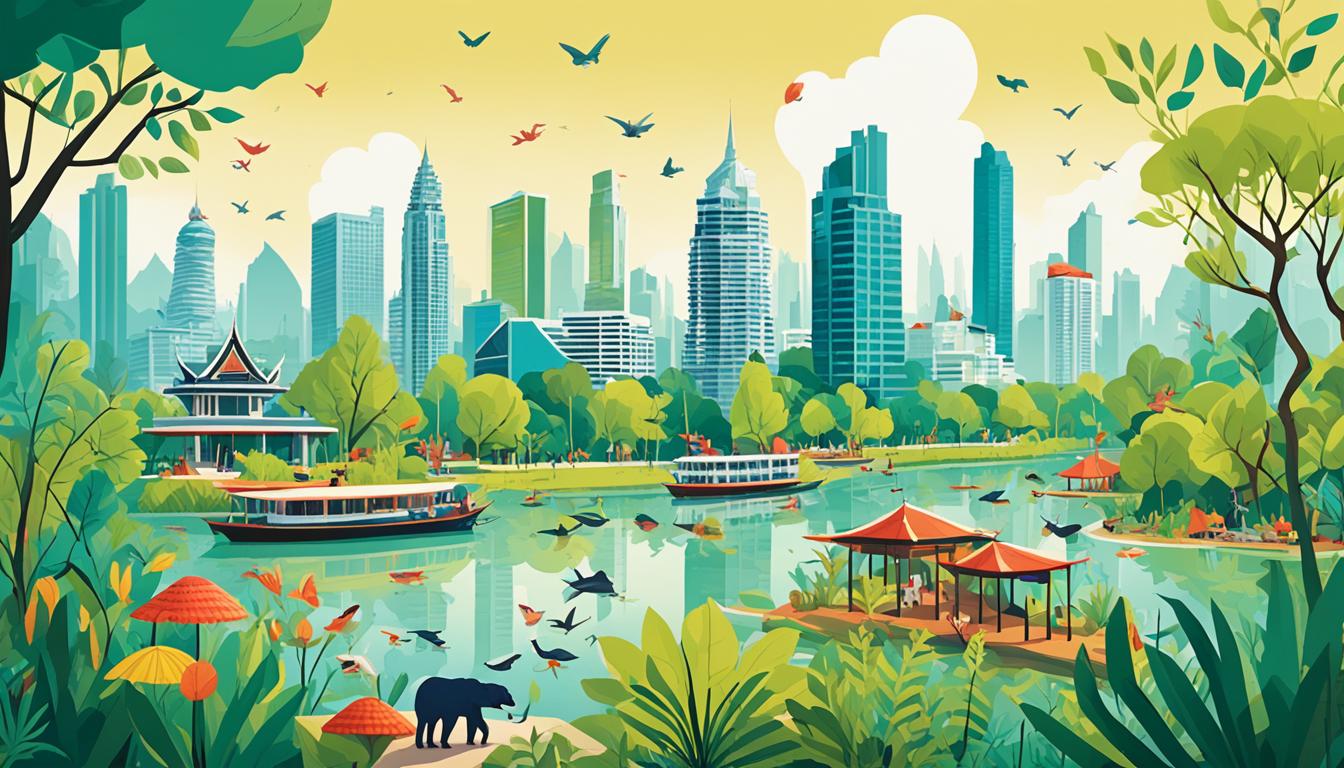Sao Tome and Principe Biodiversity and the Built Environment
Welcome to Sao Tome and Principe, a small island nation off the coast of Central Africa renowned for its remarkable biodiversity and unique ecosystems. In this article, we will delve into the diverse natural habitats of Sao Tome and Principe and explore the need for conservation efforts to protect its rich biodiversity and promote sustainable development.
Key Takeaways:
- Sao Tome and Principe is known for its exceptional biodiversity and unique ecosystems.
- Conservation efforts are crucial to protect the natural heritage of Sao Tome and Principe.
- Developing sustainable practices in the built environment is essential for the long-term preservation of biodiversity.
- Ecological architecture, environmental planning, and green infrastructure play a vital role in promoting harmonious development.
- Understanding the ecosystems of Sao Tome and Principe is crucial for effective conservation and sustainable urban design.
The Ecosystems of Sao Tome and Principe
Sao Tome and Principe, a small island nation off the coast of Central Africa, is home to diverse ecosystems that contribute to the preservation of its rich biodiversity. The country encompasses four main ecosystems – the marine and coastal ecosystem, the inland water ecosystem, the forestry ecosystem, and the agricultural ecosystem. Each ecosystem plays a vital role in supporting a wide range of species and maintaining environmental balance.
1. Marine and Coastal Ecosystem
The marine and coastal ecosystem of Sao Tome and Principe consists of the surrounding ocean, coastlines, beaches, and coral reefs. This ecosystem supports a diverse array of marine species, including fish, dolphins, sea turtles, and coral formations. It serves as a breeding ground and migratory route for several migratory birds as well. However, this ecosystem faces various threats, such as coastal erosion, overfishing, and pollution, which require urgent conservation efforts to safeguard the biodiversity and protect the livelihoods of local communities.
2. Inland Water Ecosystem
The inland water ecosystem of Sao Tome and Principe comprises rivers, lakes, and wetlands, forming vital freshwater habitats. This ecosystem is home to diverse fish species, amphibians, and aquatic plants that play a crucial role in maintaining overall ecological balance. Unfortunately, habitat destruction, pollution from agricultural activities, and the introduction of invasive species pose significant challenges to the sustainability of this ecosystem. Conservation initiatives are crucial to preserving the biodiversity and integrity of inland water systems.
3. Forestry Ecosystem
The forestry ecosystem of Sao Tome and Principe is characterized by lush rainforests that house endemic bird species and rare flora. These forests are vital carbon sinks, contributing to climate regulation and supporting various ecological processes. However, deforestation and unsustainable logging practices pose severe threats to this ecosystem. These activities result in habitat loss, decreased biodiversity, and soil erosion. Conservation efforts, including sustainable logging practices and reforestation projects, are essential for the long-term preservation of the forestry ecosystem.
4. Agricultural Ecosystem
The agricultural ecosystem in Sao Tome and Principe encompasses farmlands where crops are cultivated and livestock is raised. This ecosystem is essential for food production and contributes to the local economy. Sustainable agriculture practices, such as organic farming and agroforestry techniques, help reduce environmental impact and promote biodiversity conservation within this ecosystem. Balancing agricultural productivity with environmental stewardship is critical for ensuring the resilience and sustainability of the agricultural ecosystem in the face of global challenges.
Overall, the preservation and conservation of these ecosystems in Sao Tome and Principe are crucial for maintaining the country’s unique biodiversity and supporting sustainable development. By implementing effective conservation strategies, promoting ecological awareness and engagement, and integrating nature-based solutions into planning and management processes, Sao Tome and Principe can secure a harmonious relationship between its ecosystems and the built environment.
The Marine and Coastal Ecosystem
The marine and coastal ecosystem of Sao Tome and Principe encompasses the vast expanse of the surrounding ocean, stretches of coastline, picturesque beaches, and vibrant coral reefs. This diverse ecosystem provides a haven for a multitude of marine species, fostering a rich biodiversity that thrives within its waters.
Within this ecosystem, the marine and coastal environment supports a wide array of marine life, including various fish species, graceful dolphins, majestic sea turtles, and intricate coral formations. These components form an intricate web of life, each playing a vital role in maintaining the balance of this fragile ecosystem.
Despite its natural beauty and importance, the marine and coastal ecosystem faces numerous threats that put its biodiversity at risk. One of the primary threats is coastal erosion, which erodes the shorelines and disrupts the stability of the coastal habitats, endangering the well-being of the species that rely on them.
Overfishing is another significant challenge in this ecosystem. Unsustainable fishing practices, such as excessive trawling and the capture of undersized fish, deplete fish populations, disrupt the food chain, and disturb the delicate ecological balance within the marine environment.
Pollution poses a significant threat to the marine and coastal ecosystem of Sao Tome and Principe as well. Industrial waste, agricultural runoff, and improper waste disposal introduce harmful chemicals and pollutants into the water, affecting the health of marine organisms and compromising the integrity of their habitats.
To ensure the preservation of the marine and coastal ecosystem and safeguard the biodiversity it harbors, conservation efforts are essential. These efforts involve implementing measures to combat coastal erosion, promoting sustainable fishing practices, and reducing pollution through proper waste management and environmental education.
The Importance of Conservation
Conserving the marine and coastal ecosystem is crucial for the preservation of not only the diverse range of species but also the well-being of local communities. This ecosystem provides essential services, such as food resources, tourism opportunities, and shoreline protection against storms and natural disasters.
By prioritizing conservation and adopting sustainable practices, Sao Tome and Principe can protect its marine and coastal biodiversity, ensuring the long-term health and resilience of this precious ecosystem for generations to come.
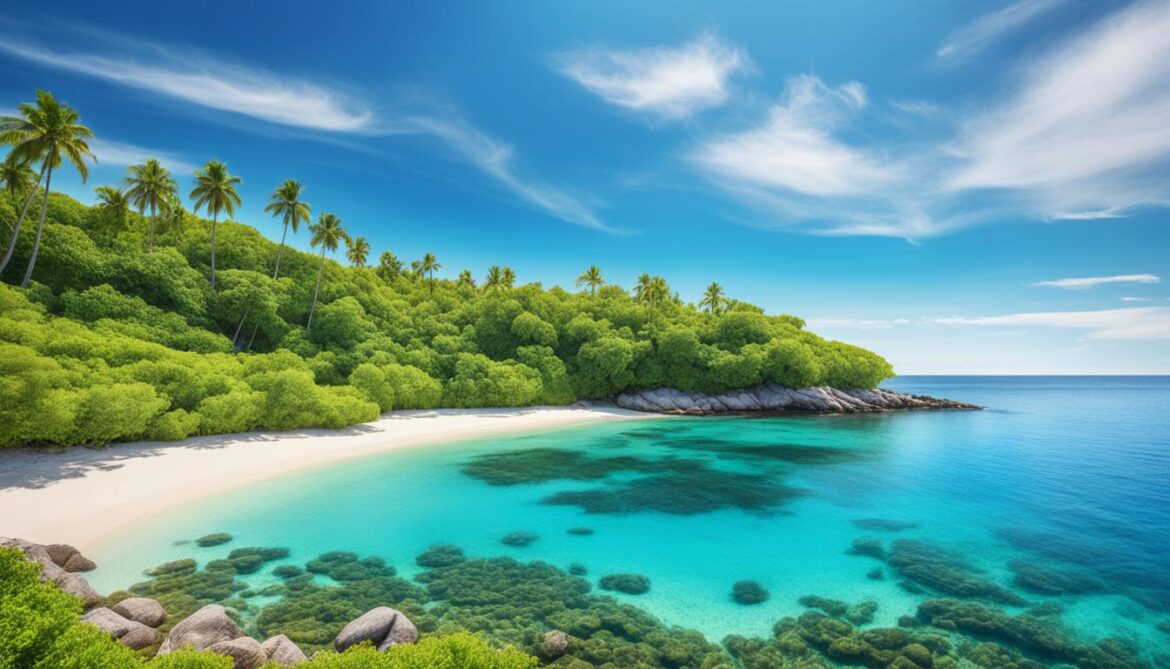
Threats to the Marine and Coastal Ecosystem
The marine and coastal ecosystem of Sao Tome and Principe is home to a diverse range of species and plays a vital role in the overall health of the environment. However, this delicate ecosystem faces a number of threats that put its biodiversity and sustainability at risk.
Coastal Erosion
Coastal erosion is a significant threat to the marine and coastal ecosystem of Sao Tome and Principe. The gradual loss of coastline and beach areas due to erosion can lead to the destruction of valuable habitats for marine species and result in the displacement of coastal communities. Rising sea levels and climate change exacerbate this threat, making it crucial to implement measures to mitigate coastal erosion and protect the integrity of the ecosystem.
Overfishing
Overfishing is another major threat to the marine and coastal ecosystem. Unsustainable fishing practices, such as excessive netting and the use of destructive fishing methods, can deplete fish populations, disrupt the food chain, and harm the overall balance of the ecosystem. Overfishing not only affects the biodiversity of the marine and coastal areas but also has significant economic and social implications for local communities who rely on fishing as a source of livelihood.
Pollution
Pollution, including the discharge of industrial waste, agricultural runoff, and plastic pollution, poses a significant threat to the marine and coastal ecosystem of Sao Tome and Principe. Contaminants can accumulate in the water, harming marine life, damaging coral reefs, and disrupting the fragile balance of the ecosystem. It is essential to address pollution through stricter regulation, proper waste management practices, and initiatives promoting environmental awareness and education.
To safeguard the marine and coastal ecosystem of Sao Tome and Principe, it is imperative that proactive measures are taken to address these threats. Conservation efforts, sustainable fishing practices, and effective pollution control strategies are crucial to protecting the biodiversity, ensuring the continued well-being of marine species, and preserving the natural beauty of Sao Tome and Principe’s coastline.
The Inland Water Ecosystem
The inland water ecosystem of Sao Tome and Principe is a vital component of the island nation’s natural heritage. It encompasses rivers, lakes, and wetlands, providing essential freshwater habitats for a diverse array of fish species, amphibians, and aquatic plants.
These freshwater ecosystems are teeming with life, supporting a delicate balance of species that rely on clean and unpolluted waters for survival. The fish species found in these waters range from small, colorful tropical fish to larger predatory species that play a crucial role in the food chain.
Amphibians, such as frogs and salamanders, also find refuge in the inland water ecosystem. These amphibians are highly sensitive to changes in water quality and serve as indicators of ecosystem health. Their presence is a testament to the ecological integrity of these freshwater habitats.
Unfortunately, the inland water ecosystem faces significant threats that jeopardize its existence and the species that depend on it. Habitat destruction, primarily from agriculture and urbanization, poses a significant risk to the delicate balance of these ecosystems.
Pollution from agricultural runoff, including the excessive use of fertilizers and pesticides, further degrades water quality and disrupts ecosystem functions. This pollution can lead to the decline of fish populations and the displacement of amphibians.
Invasive species, introduced through human activities, can also take a toll on the inland water ecosystem. These non-native species outcompete native species for resources and disrupt the natural dynamics of the ecosystem.
Conservation efforts are crucial to protect and restore the inland water ecosystem of Sao Tome and Principe. This involves implementing measures to reduce habitat destruction, promoting sustainable agricultural practices, and raising awareness about the importance of preserving these fragile freshwater habitats.
By safeguarding the inland water ecosystem, we can ensure the survival of its diverse fish species, amphibians, and aquatic plants, contributing to the overall ecological resilience of the island nation.
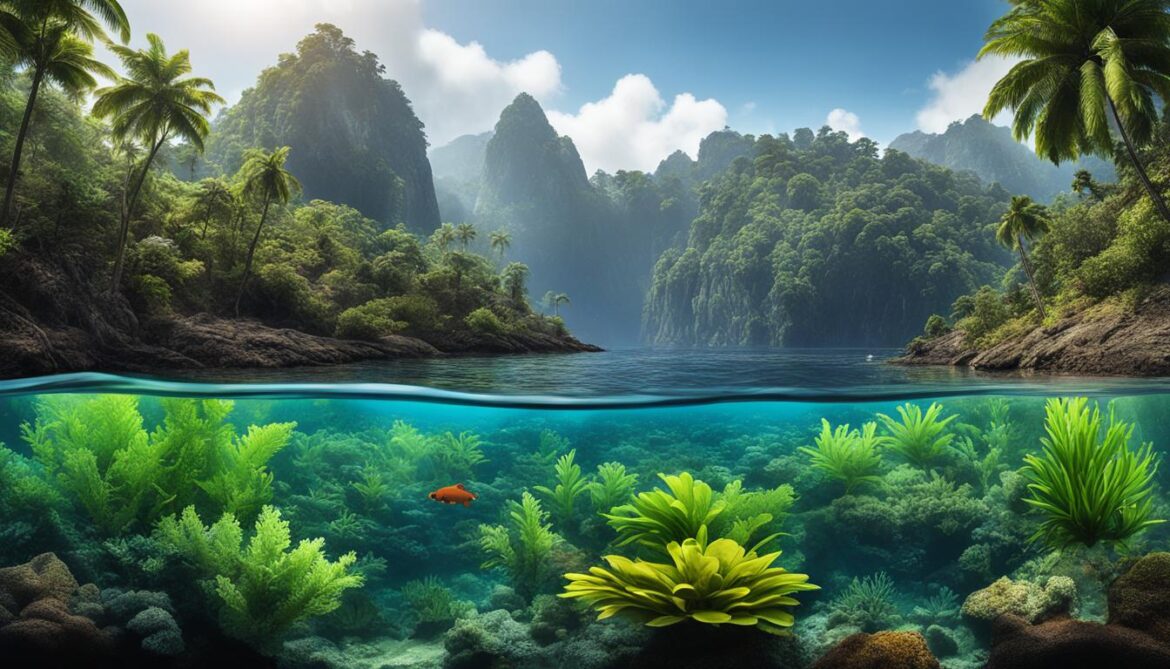
Challenges in the Inland Water Ecosystem
The inland water ecosystem of Sao Tome and Principe faces several challenges that pose a threat to its biodiversity and overall health. These challenges include habitat destruction, pollution from agricultural activities, and the introduction of invasive species. Addressing these challenges is vital to ensure the long-term sustainability of the inland water ecosystem.
Habitat Destruction
Habitat destruction is a significant challenge facing the inland water ecosystem of Sao Tome and Principe. Rapid urbanization, deforestation, and unsustainable land-use practices lead to the loss of critical habitats for aquatic species. Wetlands, rivers, and lakes are being drained or filled in for infrastructure development, disrupting the natural balance and reducing the available space for native fish and amphibians to thrive.
Pollution from Agricultural Activities
Pollution from agricultural activities is another pressing challenge in the inland water ecosystem. Excessive use of fertilizers, pesticides, and herbicides in agriculture leads to runoff contamination, which enters the water bodies and affects the water quality. The increased nutrient levels result in algal blooms, oxygen depletion, and overall degradation of the aquatic habitat. This pollution not only disrupts the ecosystem but also poses health risks to the local communities who rely on the water resources for drinking and fishing.
The Introduction of Invasive Species
The introduction of invasive species poses a significant threat to the biodiversity of the inland water ecosystem. Non-native species, such as predatory fish, algae, and plants, can outcompete and prey upon native species, leading to the decline of native populations. These invasive species disrupt the balance of the ecosystem and may cause irreversible damage to the native flora and fauna.
Conservation efforts focused on the inland water ecosystem are crucial to mitigate these challenges and preserve the unique biodiversity of Sao Tome and Principe. Implementing measures to protect and restore habitats, promoting sustainable agricultural practices, and raising awareness about the impacts of invasive species can contribute to the long-term conservation and health of the inland water ecosystem.
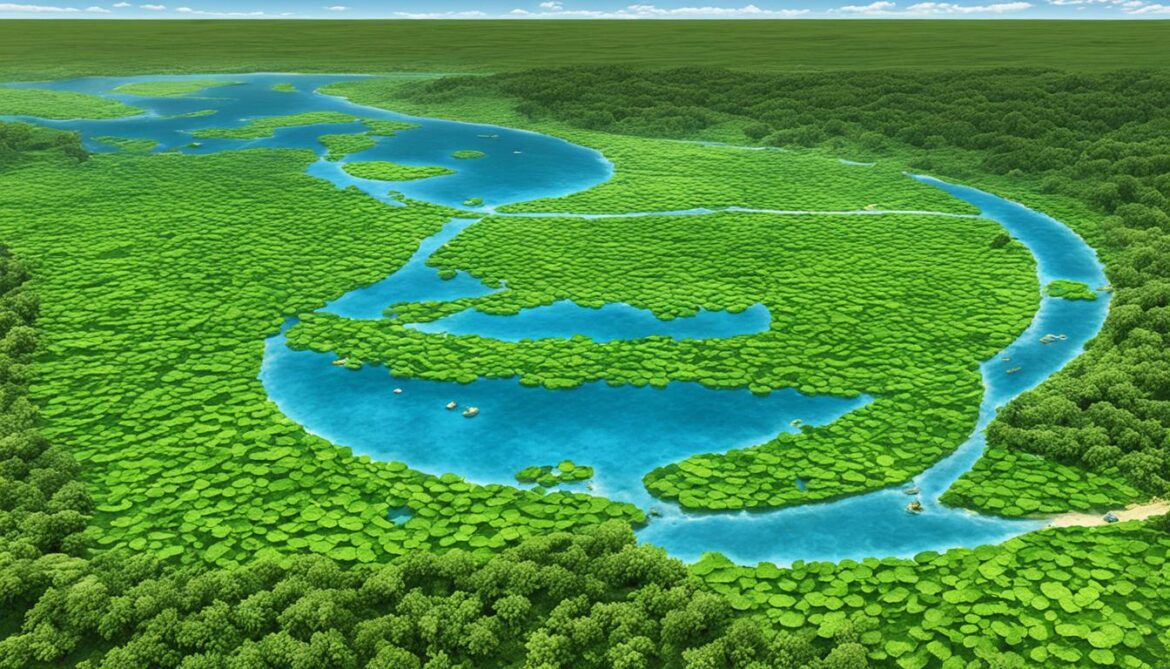
The Forestry Ecosystem
The forestry ecosystem of Sao Tome and Principe is characterized by lush rainforests that support a diverse range of plant and animal species. These rainforests are home to many endemic bird species and rare flora, making them a significant part of the country’s biodiversity.
However, this precious ecosystem is facing serious threats, including deforestation and unsustainable logging practices. Deforestation, driven by agricultural expansion and commercial logging, results in the loss of precious habitats and the destruction of key ecosystems essential for the survival of many species.
Unsustainable logging practices further exacerbate the problem, contributing to habitat loss, decreased biodiversity, and increased soil erosion. These activities disrupt the delicate balance of the forestry ecosystem, putting the survival of endemic bird species and other flora and fauna at risk.
“The loss of rainforest habitats is a direct threat to the survival of endemic bird species in Sao Tome and Principe. These unique species rely on the rainforests for food, shelter, and breeding grounds. Without concerted conservation efforts, we stand to lose these beautiful creatures forever.” – Dr. Maria Silva, Ornithologist
Conservation initiatives are crucial in addressing the challenges faced by the forestry ecosystem. Sustainable logging practices that prioritize the regeneration of forests and the protection of key habitats are essential. Additionally, reforestation efforts can help restore degraded areas and create new habitats for endangered species.
The Need for Sustainable Forestry Practices
Implementing sustainable forestry practices can help strike a balance between the economic benefits of logging and the conservation of the forestry ecosystem. By adopting sustainable harvesting techniques and supporting community-led forestry management initiatives, Sao Tome and Principe can ensure the long-term viability of its forests while supporting local livelihoods.
Sustainable forestry practices involve selectively logging mature trees, ensuring the regeneration of the forest by allowing younger trees to grow. This approach helps to maintain forest cover and protect important habitats for endemic bird species and other wildlife.
“Sustainable logging allows us to meet our economic needs while keeping our forests intact. By carefully selecting trees for timber extraction and planting new trees to replace them, we can ensure the sustainability of our valuable rainforest ecosystems.” – Pedro Gomes, Local Forester
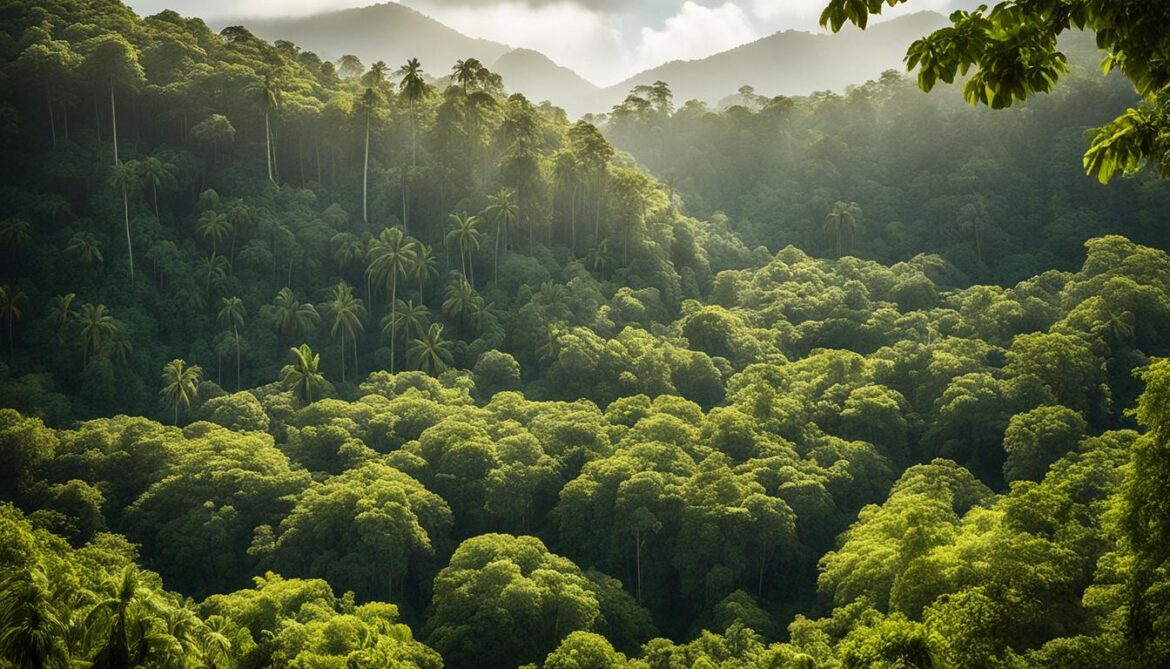
Conservation organizations, government agencies, and local communities need to work together to enforce regulations, monitor logging activities, and promote sustainable forestry practices. Through collaborative efforts, Sao Tome and Principe can protect its unique forestry ecosystem, preserve endemic bird species, and ensure the long-term sustainability of its forests.
Issues in the Forestry Ecosystem
The forestry ecosystem of Sao Tome and Principe is facing significant challenges that require immediate attention and action. One of the most pressing issues is deforestation, which involves the removal and destruction of trees and vegetation. Deforestation not only disrupts the natural balance of the forestry ecosystem, but it also leads to various adverse effects on the environment and local communities.
Unsustainable logging practices contribute to the problem of deforestation. These practices involve the excessive extraction of timber without proper consideration for the long-term viability and regeneration of the forest. The relentless pursuit of profit often overrides the importance of conservation and sustainable forest management.
The consequences of deforestation and unsustainable logging practices extend beyond the immediate loss of trees. They also result in habitat loss, which affects numerous species that depend on the forest for survival. The biodiversity loss caused by deforestation can have far-reaching effects, disrupting the delicate balance of the forest ecosystem and altering the interactions between different species.
Furthermore, deforestation and unsustainable logging practices contribute to environmental degradation. Forests play a crucial role in stabilizing the climate by absorbing carbon dioxide and releasing oxygen. The removal of trees not only releases carbon dioxide into the atmosphere but also diminishes the earth’s ability to mitigate climate change.
Conservation efforts are essential to address these issues and protect the forestry ecosystem of Sao Tome and Principe. This includes implementing sustainable logging practices that allow the forest to regenerate naturally, promoting the restoration of degraded areas, and establishing protected areas to safeguard the biodiversity of the ecosystem.
Critical Quote: “Deforestation and unsustainable logging practices not only harm the environment but also threaten the livelihoods of local communities who depend on the forest for sustenance.” – Environmentalist Jane Mitchell
The Importance of Conservation
Conservation initiatives are crucial to ensure the long-term survival and well-being of the forestry ecosystem in Sao Tome and Principe. By promoting sustainable forest management and raising awareness about the importance of preserving the forest, we can protect valuable habitats, preserve biodiversity, and mitigate the effects of climate change.
Conservation efforts should involve collaboration between government bodies, environmental organizations, local communities, and international partners. Together, we can support responsible practices and innovative approaches that balance the economic value of the forest with its ecological significance.
To successfully address the issues facing the forestry ecosystem, widespread education and advocacy are essential. By highlighting the importance of responsible forestry practices and the impact of deforestation on biodiversity and climate change, we can inspire collective action and foster a deep sense of stewardship for the forest.
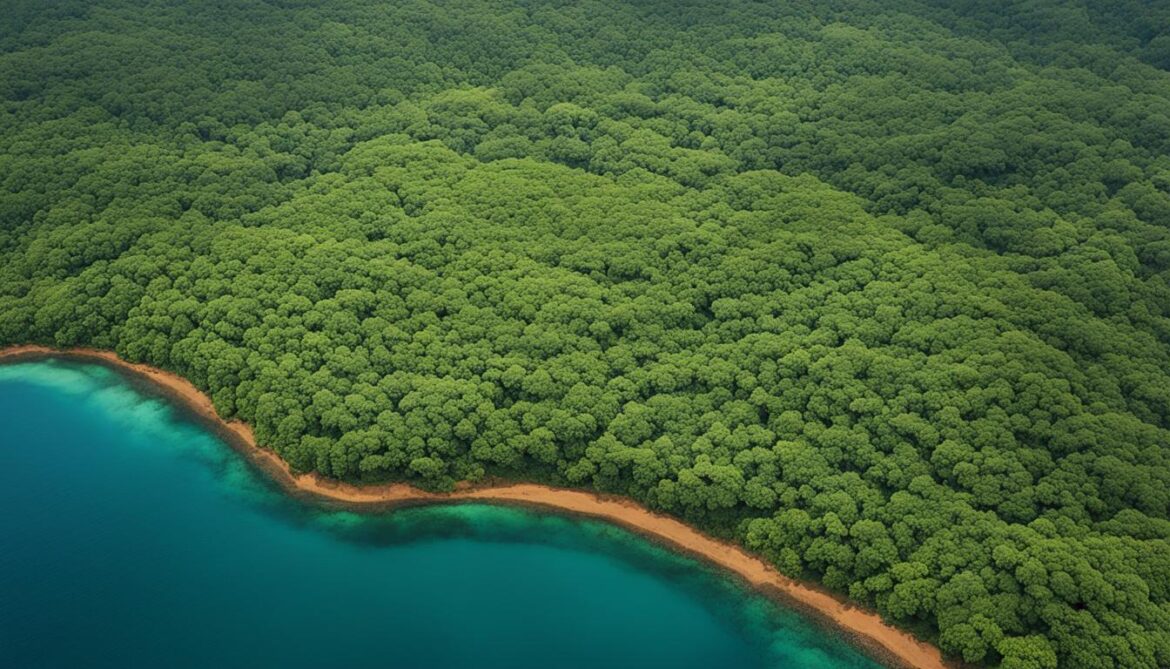
Conclusion
Sao Tome and Principe, with its remarkable biodiversity and unique ecosystems, is facing significant challenges in conservation and sustainable development. The protection and preservation of the marine and coastal, inland water, and forestry ecosystems are crucial for the island nation’s natural heritage. By implementing conservation initiatives and promoting sustainable practices, Sao Tome and Principe can ensure the long-term survival of its rich biodiversity and foster a harmonious relationship between biodiversity and the built environment.
Conservation efforts are essential for safeguarding the marine and coastal ecosystem, which is under threat from coastal erosion, overfishing, and pollution. By addressing these challenges, Sao Tome and Principe can preserve the diverse marine species, coral reefs, and coastal habitats that are vital for the well-being of both the environment and local communities.
The inland water ecosystem, comprising rivers, lakes, and wetlands, is home to numerous fish species, amphibians, and aquatic plants. However, habitat destruction, pollution from agriculture, and the introduction of invasive species pose significant threats. To protect this essential ecosystem, Sao Tome and Principe must prioritize conservation efforts and restore the balance of its inland water resources.
The forestry ecosystem, characterized by lush rainforests and endemic bird species, is at risk due to deforestation and unsustainable logging practices. The consequences of these activities include habitat loss, decreased biodiversity, and soil erosion. Therefore, Sao Tome and Principe must take immediate action to preserve its forestry resources through conservation measures and the promotion of sustainable forestry practices.




